Martial et Armand: Tailored Elegance and Seaside Sophistication for the Modern Parisienne
📌 Explore the tailored elegance and luxurious textures of Martial et Armand’s Parisian couture, from bold coats and robe-manteaux to glittering evening gowns. Discover how this house redefined travel fashion and 1920s modernity.
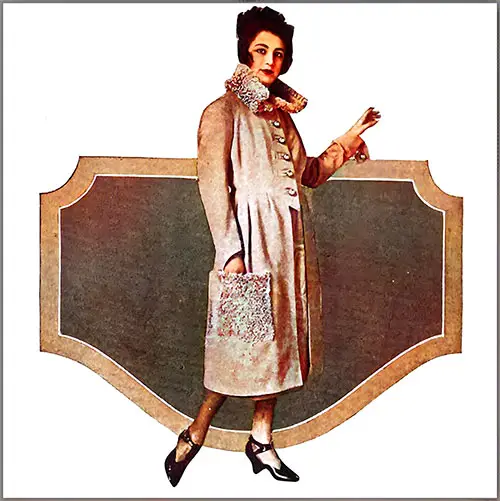
Coat Matching the Fawn Duvetyn Dress; Collar and Deep Pockets of Lamb. Tailleur Jackets Are Comparatively Short With High Collars, Long Sleeves, and Narrow, Straight Outlines Which Distinguish Afternoon Dresses Made of Heavy Fabric. (Garment Manufacturers' Index, September 2020) | GGA Image ID # 1c9edb434c
🎩👒 Martial et Armand – Elegance Reimagined for the Modern Traveler
Since its founding in 1902 and under the sophisticated direction of Madame Vallet, Martial et Armand evolved into a dynamic force in Parisian couture, offering sharp tailoring, rich fabrics, and experimental silhouettes that harmonized refinement with modern flair.
From the elite promenades aboard ocean liners to afternoon teas in garden salons, Martial et Armand’s creations exemplified how fashion moved with women—gracefully, purposefully, and always in style. 🛳️💃
Martial et Armand, established in 1902, has been completely renovated and, we may say, rejuvenated by its present directress, Madame Vallet. Thanks to her alert supervision and excellent personal taste, this firm grows in repute every season.
At Martial et Armand, the potential pitfall of the unwary dressmaker, tailored suits, are not just a focus, but a masterpiece of meticulous attention to detail. This reassures our customers about the uncompromising quality they can expect.
The line at Martial et Armand is excellent, youthful, and trim. This emphasis on modernity and style will make our audience feel trendy and stylish.

“Salome” Is an Evening Gown Made of Gold Sequins by Martial et Armand. the Back Panel, Which Also Forms a Girdle, Is Made of Black and Multicolored Sequins. Green and Gold Cabochons Trim the Corsage at the Waistline. Photo by Henri Manuel, Paris. (La France, November 1920) | GGA Image ID # 1cd2b77f1e
This winter, the jackets here are shorter than usual; most are halfway to the knee, flare very little, and sometimes have belts and open-over-trim waistcoats.
The collars are high, fitting well over the chin and fur but arranged so they may be worn open. A blue velours de laine is cut prettily into a deep pointed hood at the back, but the "sensational" number of the whole collection is a tailleur made entirely of gazelle fur!
It is beautifully soft and supple as stuff to handle, so why not make it like this one, into a shortish coat, rather close-fitting at the waist, with a ruched, brown satin collar? The skirt is worn with a green and gold brocade blouse, joining the fur well over the hips to avoid bulk at the waist.
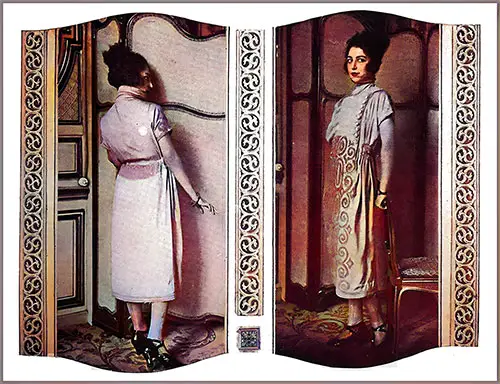
The Image Above Features an Afternoon Dress by Martial et Armand, Made of Fawn Satin and Adorned With Appliquéd Duvetyn Embroidery. (Garment Manufacturers' Index, September 2020) | GGA Image ID # 1c9f0889d1
The following are examples of three-quarters, medium, and short coat suits, each entirely different.
First, a knee-length jacket of green and red plaid blanket cloth has the side gores cut diagonally and in points: as the skirt repeats the idea, the profile view of the side is longer than the front.
The second model, of blue duvetyn, is medium-length and trimmed down the front by a broad band of gray Persian lamb, which also makes the tight collar and cuffs; a wide red and gray leather belt completes the Russian effect.
Lastly, we have a chic little black velvet affair. The jacket fits tightly at the waist. The twelve-inch basque, shirred on very full, is trimmed by tiny strips of ermine sewn on crisscross, like herring-boning: the high collar is a ruff framing the face, adorned in the same way with ermine, the whole effect being charming.
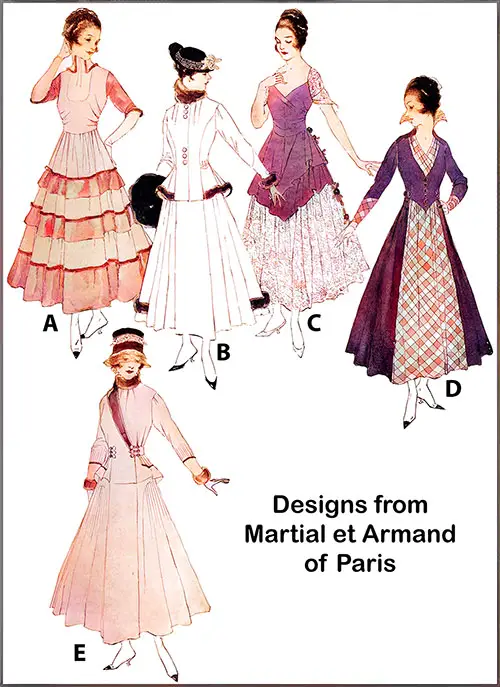
Martial et Armand of Paris Has Shared Their Predictions for Spring Fashion. They Forecast a Comeback of the Short Jacket With a Flared Bottom, While Skirts Will Remain Short but Less Voluminous. We Can Expect a Wide Variety of Sleeve Styles and the Growing Popularity of Beige and Grey for Early Spring. Additionally, There Is a Noticeable Trend Leaning Toward the Fashion Styles of the 1830s and 1840s. Harper's Bazar, January 1916, p. 61. GGA Image ID # 1cd7334e2a
(A) A 1916 débutante might wear this gown offichen grey taffeta The triple velours bands, sleeves and collar are edged with fur. The guimpe of white crêpe lisse in tensifies the youth fulness of the design.
(B) The back and front panels of this black velours tailleur extend from skirt to jacket: the side sections are laid in plaits. Dark brown fur finishes the edge of skirt and jacket and makes the collar.
(C) An interesting dancing frock has the corsage and short overskirt flounces of pink faitle. The sleeves and skirt are of flowered mousseline. A garland of roses decorates the left side.
(D) Marine blue taffeta, combined with checked taffeta in marine and light blue shades, makes this typical Martial et Armand design. Braided collar and bodice ornaments are pleasing details.
(E) This brown broadcloth tailleur, with its small waisted jacket and plaited skirt, will please those who have fores worn kimono sleeves. The collar, which ends as a lapel, is of beaver.
Afternoon coats often match or echo the dress worn underneath, making them a prominent feature in winter wardrobes. Here, we highlight a selection of very stylish coats, including one made of black velvet, almost straight in design, with white silk leaves embroidered along the sides in a chain-stitch pattern. This coat is paired with a robe-chemise made of white Georgette, which is also chain-stitched, this time in black silk. It features an opening in the front that reveals a Georgette underskirt.
This brings us to coat dresses, a significant element in any good collection. They are referred to as "robes-manteaux" primarily because they fasten visibly down the front, and they closely resemble robe-chemise styles.
These coat dresses are generally loose and straight, sometimes featuring belts like the one exhibited here, made of beige gabardine. The collar and sash are made of a shiny ribbon that mimics snakeskin.
Another noteworthy piece is a blue serge coat (a new type with a fancy gray selvage checked in green) that fastens at the side beneath a gray band, which serves as its only trimming.
A sensible guideline when choosing afternoon dresses using heavier fabrics is to incorporate high collars, long sleeves, and narrow, straight outlines. This can be done as described earlier or by adding a close-fitting overskirt, panel, apron, or tunic to make the design more interesting.
For instance, one blue serge dress features rounded swinging panels in the front, adorned with cut-out motifs made of old-rose cloth and jet, which are connected to the skirt by a jet girdle. Another piece, a burnt orange duvetyn dress, comes with a waxed satin sash (noting the generous use of satin ciré at Martial et Armand's) and features an apron of silver lace embellished with applications of the duvetyn fabric.
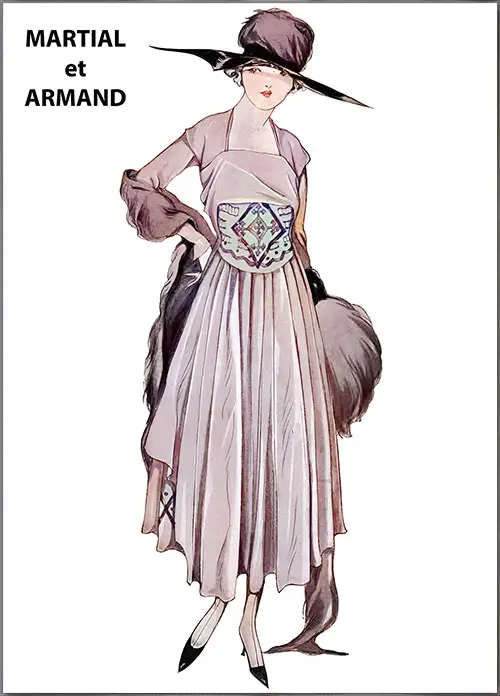
The Martial et Armand Dress Is of Taupe Satin, While the Girdle Is Taupe Cloth Embroidered in Conventional de Sign in Salmon and Brown Silks. A Fold of Salmon Chiffon Finishes the Neck. (Harper's Bazar, November 1916) | GGA Image ID # 1cd77eee31
Even though fur is scarce, it's rare to find a dress without some fur accents. For example, green cloth features an Astrakhan collar, a gray melton paired with a squirrel vest, and a beige duvetyn complemented with skunk fur. The combination of beige and gray is particularly popular.
Conversely, reception and dinner dresses, often made of light crêpes and chiffons, create an indistinct silhouette while maintaining a straight outline.
We have an extensive selection of fabrics, including black satins and velvets, gray Georgette, black and white materials, silver crêpe de Chine brocaded with velvet, and chiffon in various shades, such as orange, flame, and brick.
A striking black lace dress features an unexpected satin ciré sash and loops. Various lace designs are combined with fitted velvet bodices; one bodice is black velvet with a gold embroidered front and includes tiny shirred basques supporting a long black lace apron that trails behind the skirt. Another bodice of dark green panna showcases a green net overskirt cut into strips, with edges trimmed in skunk fur.
An open-coat tunic crafted from coral pink Georgette, trimmed with gazelle fur, is worn over biscuit satin.
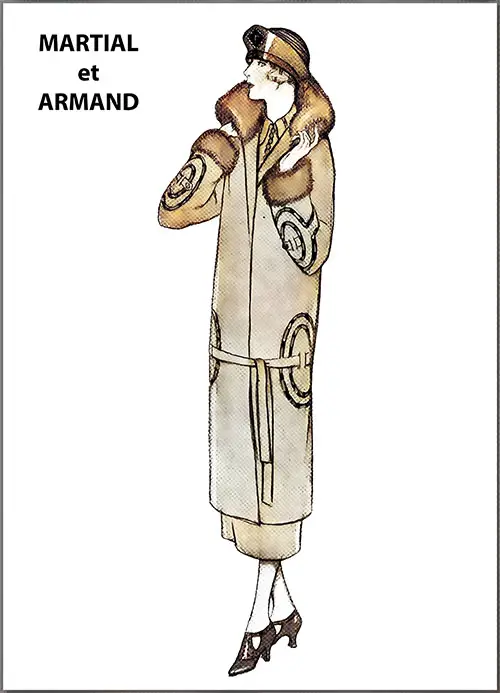
From Martial et Armand, We Have a Dress and Coat That Combine a Leek-Green Velours de Laine With an Audacious Tartan-Plaid Silk. the Silk Dress Has Just a Cloth Band at the Bottom. Illustration by Helen Thurlow. (Woman's Home Companion, September 1924) | GGA Image ID # 1cd3603279
The robe chemise exists here; of course, one of childlike simplicity is pink and gold brocade with a low sable belt. Crossed bodices covering the arm-tops are numerously represented. One of the smartest is black satin, the fichu effect fastening at the side under a huge disk of mother of pearl. The skirt opens in front, revealing a black Georgette embroidered in large white silk circles.
Evening gowns are conservative, distinguished in line, and inclined to points: pointed necks, trains, and panels. A chiffon velvet of a soft shade of scarlet beautifully draped with a low torsade belt (a strip of the stuff rolled into a thick cord ) is cut into unequal lengths, resulting in a fish-tail train. The neck is a V-cut; chains of jet heads hang from one shoulder and fasten on the opposite side.
Pale pink brocade with a silver bodice and straps are lovely; dyed lace, employed with lamés and charmeuse in a thousand different capes and draperies, promises to be a great feature of the winter styles.

A Martial et Armand Afternoon Frock of Dark Blue Taffeta Checked In Gold Over Grey Lining. The Back of the Bodice Is a Bolero. (Garment Manufacturers' Index, April 1921) | GGA Image ID # 1a3d25d586
Once upon a time, about five years ago, new management took over the old firm of Martial et Armand.
Since then, the directress, Madame Vallet, has completely changed the aspect of this one-time sleepy house thanks to her excellent personal taste. She takes the principal part in business matters and design and builds up the fortunes of her house. The list of buyers of all nationalities steadily increases, among which we find many well-known North and South American names, which is unsurprising considering how good the spring collection is.
The dresses were certainly longer and somewhat narrower, and much ingenuity had been expended on the finish of the skirts' edges. They had, for instance, a decided tendency to hang lower at the back than in front or were rounded off in irregular waves to follow the droop of the skirt's folds. Heavy fabric sleeves showed no change, being close-fitting and long.
Although every branch of the sartorial art is well represented, from severe morning and sport suits to beautiful evening wraps, one of Martial et Armand's significant assets is an extensive and unrivaled collection of afternoon and reception frocks.
Another good feature is the combination of all sorts of materials and colors, which results in perfect harmony and a new effect.
For instance, a blue serge gown is chic and trimmed with coarse gray string lace. A beige canvas coat striped with lacquered ribbons presents an unusual ensemble. An afternoon dress of cream lace ciréd into a lovely sheen has panels weighted down by applications of blue cloth in large designs on the lace.
To return to afternoon gowns, they are the daintiest creations of lace foulard, twill, or taffeta. The becoming natural lines, with a few light draperies or ruffles, are adopted here.
I cannot resist describing a charming model or "transformation," as it is called, for it serves two occasions, afternoon and evening. As a dinner dress, it is a filmy, soft combination of delicate lace and chiffon, over which for the afternoon is worn a long-sleeved bolero and wide "apron" of old rose taffeta. For evening wear, preference is shown for statuesque models jetted and spangled or draperies of rich brocades.
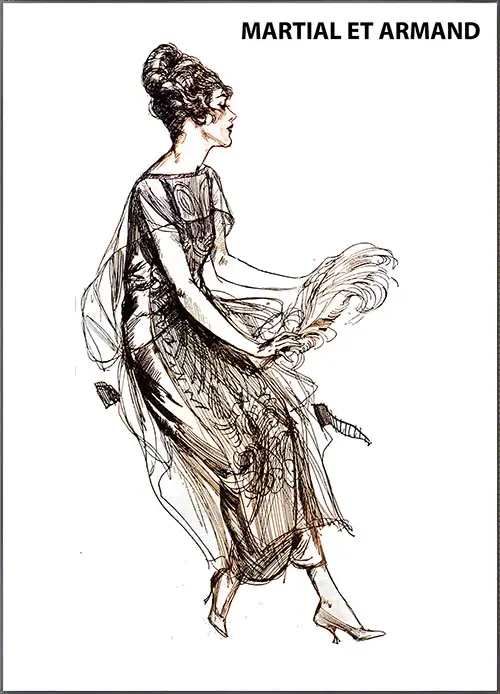
Martial et Armand Sketch of a Black Satin Evening Gown. (The Delineator, March 1919) | GGA Image ID # 224faeb6ee
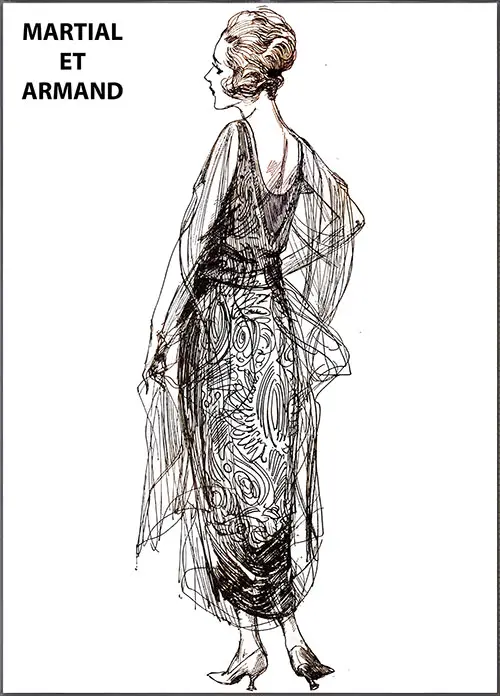
Martial et Armand Present a Stunning Dress. (The Delineator, March 1919) | GGA Image ID # 224fb2bfa1
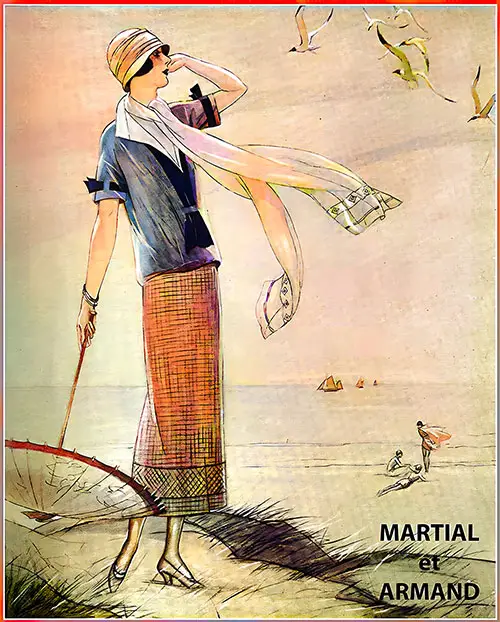
Colorful Dress for Summer by Martial et Armand. Drawn by F. L. Nicolet. (Woman's Home Companion, July 1924) | GGA Image ID # 1cd37fd7b3
The Boyish Mode
Contrary to its name, the boyish mode is not too strong-minded or obtrusively masculine. It goes in for slim hips, to be sure, and eschews fuss and feathers. It is partial to pockets and carries an intimation of swagger. But that it still insists upon its fair share of femininity, there's happily not much doubt.
Otherwise, you may be sure the French would have nothing to do with it. Martial et Armand interpret the boyish mode in red and brown plaid woolen and red crêpe de chine. The rolling collar of white muslin emphasizes youth, and there's a good bit of dash about how the necktie and sleeve ribbons dispose of themselves through slashes in the blouse. It's a sportsmanlike costume that should be able to make itself at home out-of-doors.
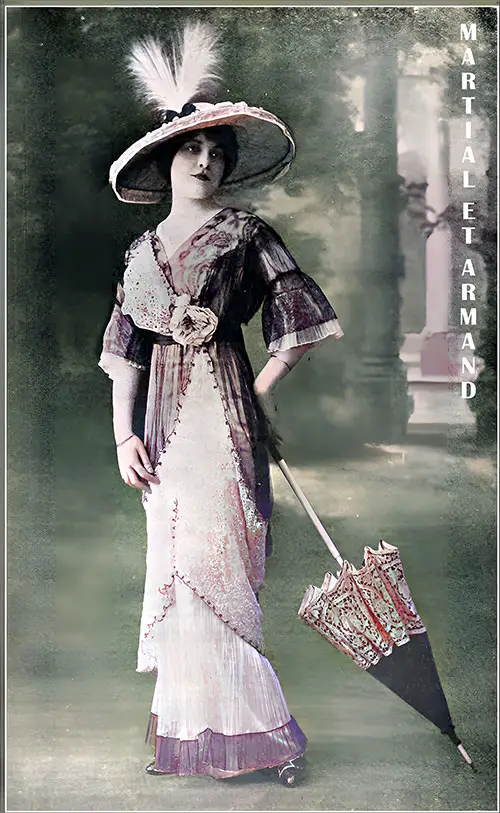
Garden Party Gown by Martial et Armand. Photo by Félix. (The Pall Mall Magazine, August 1912) | GGA Image ID # 1cb3e17d69
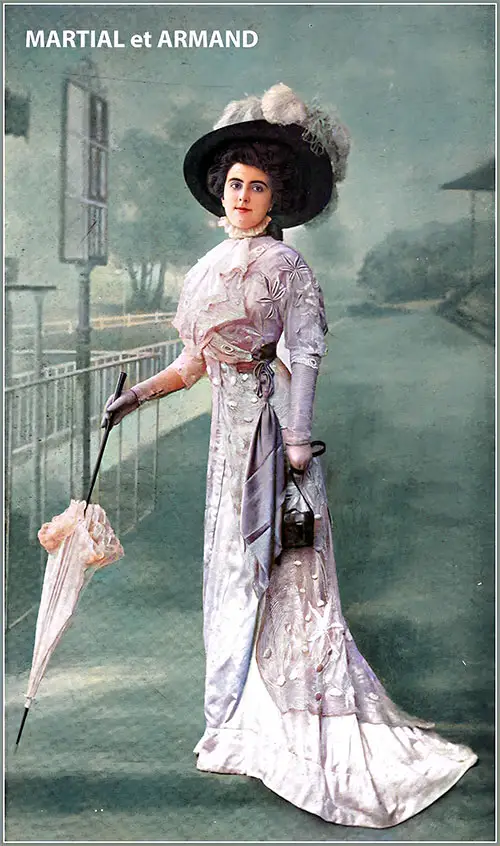
The image above is an Afternoon Gown by Martial Et Armand. The dress is made of Embroidered Net in Canary and White. The net Forms an Oversized Frock Coat Over a Skirt in Liberty Yellow, Accented With a Crimson Sash. Photo by Félix. (Les Modes, July 1908) | GGA Image ID # 1cb4370e10
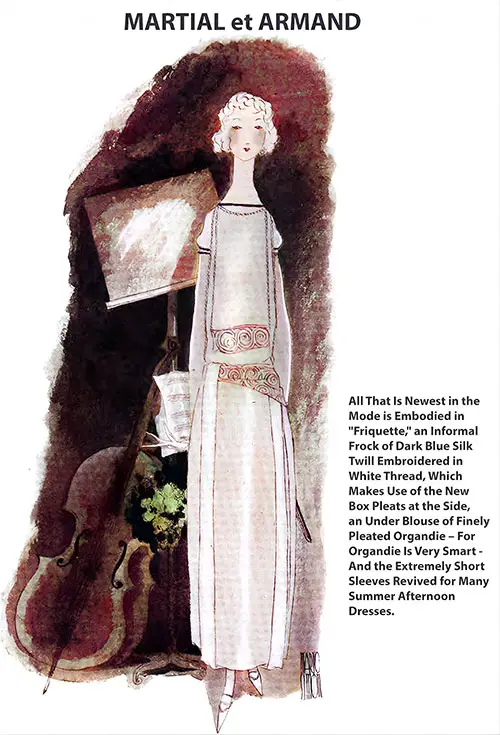
The Latest Trend Is Captured in “Friquette,” an Informal Dress Designed by Martial Et Armand. This Dress Is Made of Dark Blue Silk Twill, Embroidered With White Thread, and Features Innovative Box Pleats on the Sides. It Includes a Finely Pleated Organdie Under the Blouse—Organdie Is Currently Very Stylish—and Extremely Short Sleeves, a Revival Seen in Many Summer Afternoon Dresses. (Vogue, 1 April 1922) | GGA Image ID # 224fd09621
"Contrast is the spice of fashion," claim Martial et Armand, who use black ciré voile for the short flared coat and plaid ciré voile for the high-collared dress of a three-piece costume. (The Delineator, June 1921)

The Image Above Is of a Stunning Evening Gown and Cap in Cream Georgette Lace by Martial et Armand. (The Graphic, 6 May 1922) | GGA Image ID # 224fa2fe63

A Beautiful Costume by Martial et Armand in Grey Fabric, Embellished With a Soft Shade of Tomato Silk. (The Graphic, 13 May 1922) | GGA Image ID # 224f4ddbe9
Bibliography
"Martial et Armand" in the Garment Manufacturers' Index, New York: The Allen-Nugent Co. Publishers, Vol. II, No. 2, September 1920: 22-23.
"Martial et Armand," in Garment Manufacturers' Index, New York: The Allen-Nugent Co. Publishers, Vol. II, No. 9, April 1921. p. 19.
🔍 Why It Matters: Educational & Historical Relevance
📚 Teachers & Students: This article is a treasure trove for exploring 1920s fashion history, gender norms, and the interplay between style, identity, and global travel. It invites research into the visual language of dress during the interwar years and offers concrete primary source material.
👨👩👧 Genealogists: The wide-ranging designs—from tailored coats to lavish evening gowns—reflect class, occasion, and seasonal trends, helping contextualize ancestors' photographs, ship manifests, and wardrobes.
🕰️ Historians: Martial et Armand’s adoption of the robe-chemise, short jackets, and fur-trimmed tailoring offers insight into post-WWI cultural shifts, the impact of mass travel, and the democratization of couture fashion.
💫 Most Engaging Content Highlights
🧵 1. From Paris to Port: The Ocean Travel Connection
Fashionable travelers sailing to or from Europe in the 1910s–1920s often shopped in Paris before boarding or after disembarking. Martial et Armand’s adaptable designs—such as robes-manteaux, practical three-piece suits, and removable overskirts—were ideal for the transitional nature of shipboard fashion, where elegance met movement. 🌊👜
✨ 2. “Salome” Evening Gown of Gold Sequins | GGA Image ID # 1cd2b77f1e
The dramatic “Salome” gown sparkles with gold, multicolored sequins, and cabochons, capturing the bold spirit of postwar celebration. A perfect representation of how evening fashion embraced luxury and showmanship—ideal for a ship’s grand ballroom or a reception in New York or Monte Carlo. 🌟💃
🧥 3. Tailoring & Coats That Speak Volumes
Fawn duvetyns, plaid blanket cloths, and astrakhan-trimmed jackets illustrate how Martial et Armand married comfort with sharp lines. The focus on high collars, clean outlines, and sumptuous textures made their coats a winter cruise must-have.
👗 4. Afternoon Transformations
A particularly enchanting concept is the “transformation” dress: an afternoon gown that, with the removal of a bolero and apron, transforms into an ethereal evening frock. This practical magic is perfect for travelers needing style versatility without overpacking.
🎨 5. Color & Texture Innovation
Expect the unexpected—taupe satin, tomato silk, coral pink Georgette, and bold plaids are combined with rich fur, satin ciré, and jet embroidery. These combinations embody Martial et Armand’s philosophy: "Contrast is the spice of fashion."
📸 Noteworthy Image Captions
🧥 Tailleur of Fawn Duvetyn: A quintessential example of afternoon elegance, trimmed in lamb—practical, tailored, and chic.
💛 Garden Party Gown in Canary & Liberty Yellow (GGA # 1cb4370e10): Evokes the Edwardian taste for light and femininity, contrasting nicely with postwar simplicity.
🔷 Leek-Green Coat with Audacious Tartan (GGA # 1cd3603279): An eye-catching ensemble that typifies Martial et Armand’s flair for bold material pairing.
🖤 Black Satin Gown with Jet Chains: A pointed train and V neckline offer old-world drama, while the asymmetric jet details are definitively 1920s. Ideal for onboard formal dinners or Paris soirées.
🎀 Checked Blue Taffeta Frock with Bolero Back (GGA # 1a3d25d586): A perfect balance of playfulness and polish—great for an afternoon promenade or café visit.
📚 Mini Dictionary of Fashion Terms
Astrakhan: Curly lamb fleece used as a fur trim.
Basque: A close-fitting bodice or jacket extending over the hips.
Ciré: A fabric finish that gives a high-gloss, waxed appearance.
Duvetyn: A soft, brushed woolen fabric with a suede-like feel.
Guimpe: A yoke or blouse insert often seen under bodices.
Jet: Black glass or gemstone beads, used for embroidery.
Robe-chemise: A simple, straight-cut shift dress popular in the 1920s.
Tailleur: A woman's tailored suit, typically jacket and skirt.
Velours de laine: Wool velvet—soft, thick, and warm.
🎓 Final Thoughts for Educators & Researchers
Encourage students to explore:
🔹 The intersection of fashion and identity in early 20th-century society.
🔹 How post-WWI attitudes influenced practical, tailored, and transformable designs.
🔹 The role of Parisian couture in global fashion, including its visibility in transatlantic travel, colonial trade, and immigrant journeys.
🧳Use Martial et Armand’s garments as primary sources in essays on:
🔹 The evolution of women’s freedom of movement (both sartorial and social),
🔹 The design needs of travelers aboard luxury liners,
🔹 The transformation of older fashion houses under female leadership.
